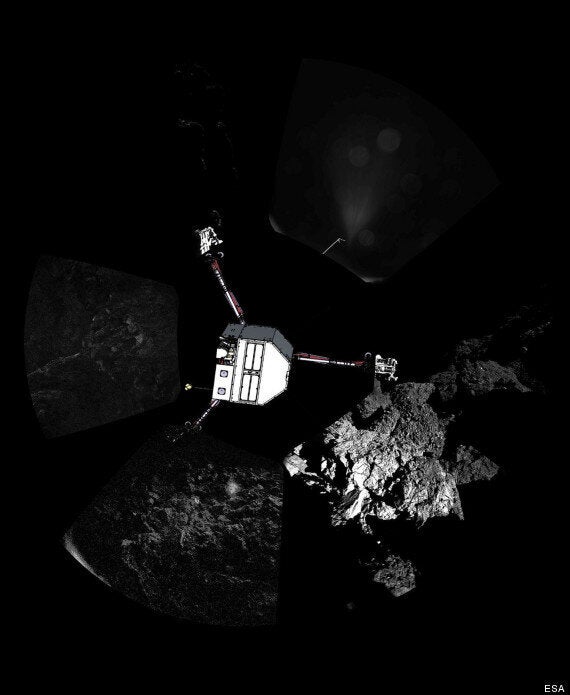The European space probe which landed - awkwardly but spectacularly - on a comet earlier this week is almost dead due to a lack of power. But scientists are still ecstatic about its performance so far - and are hopeful that they might be able to revive it - if they can move the probe into the sunlight.
The Philae lander is resting at an angle in the shadow of a crater wall more than half-a-mile from its planned landing site, scientists believe.
One of its three legs appears to be suspended in space while the other two have made contact with the ground.
Here is the latest image of the lander - it's a before and after so you can see where the lander actually is.


ESA operations chief Paolo Ferri told journalists that the Philae craft has enough battery power left to communicate with the orbiting Rosetta craft for one or two more passes before the power runs out.
Ferri said that the craft has done all the science it can without mechanical movements - like deploying a drill to try and break the surface of the comet and see what's inside.
He said they have already deployed a hammer into the surface of the comet, and may attempt to drill later on Friday.
After that they may attempt to rotate the lander into the sunlight - if they have enough power.
ESA is also holding out hope that the lander could be revived if changes in the comet's position or activity on its surface means more light can get to its solar panels.
Scientists are still trying to establish precisely where the probe ended up on comet 67P/Churyumov-Gerasimenko, a 2.5 mile rugged lump of ice and dust more than 300 million miles from Earth.
As the news emerged it became clear how narrowly the landing mission averted disaster.
After being released from its Rosetta mothership, Philae descended as planned to a relatively flat area on the smaller of one of the comet's two lobes.
But two harpoons that were supposed to anchor the craft to the surface failed to deploy and the probe bounced a kilometre (0.6 miles) into space, remaining suspended above the comet for nearly two hours.
Drawn by the comet's ultra-low gravity, it slowly fell again and bounced a second time before finally coming to rest - apparently to one side of a large crater.
The craft is partly in the shadow of a cliff-like wall, which could seriously hamper its ability to generate electricity from its solar panels.
By using one of Philae's instruments to transmit radio signals through the comet, scientists were able to obtain a rough idea of its location.
They believe it to be about a kilometre away from the original landing site.
Speaking at ESA's mission control centre in Darmstadt, Germany, lander scientist Professor Jean-Pierre Bibring, said:
"We are below a cliff. Don't ask me how many metres, but very close by. Because of that we are in a sort of a shadow permanently, and that is a problem.
"We're almost vertical; one foot probably is in open space and two feet are on the surface."
Pointing to a large image of the comet, Philae lander manager Dr Stephan Ulamec added: "It could be that we are somewhere in the rim of this crater, which could explain this bizarre orientation."
The scientists revealed that the probe could theoretically "hop" to a better position by moving its landing gear.
But this was unlikely to be attempted because of the amount of power it would drain.